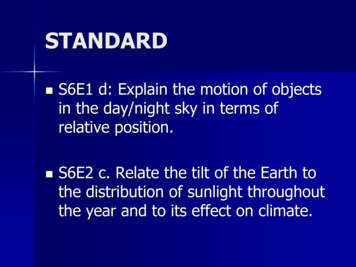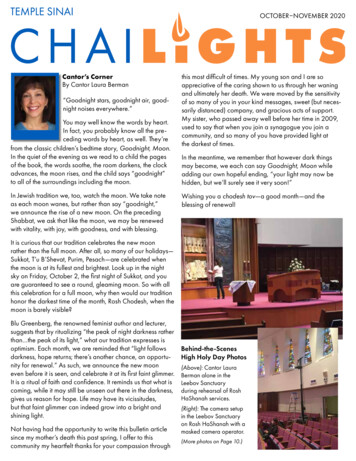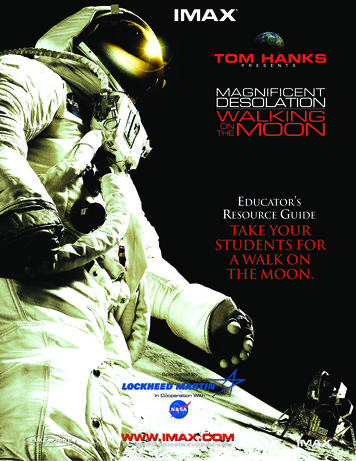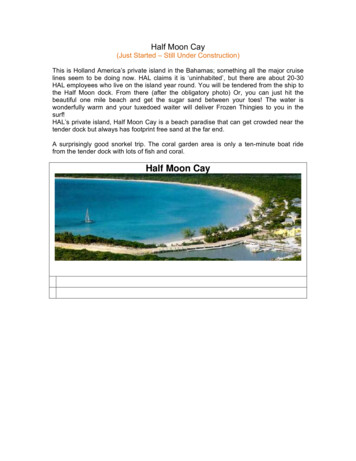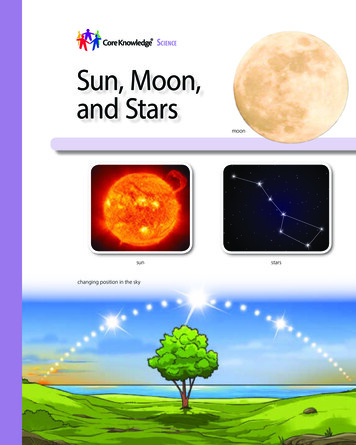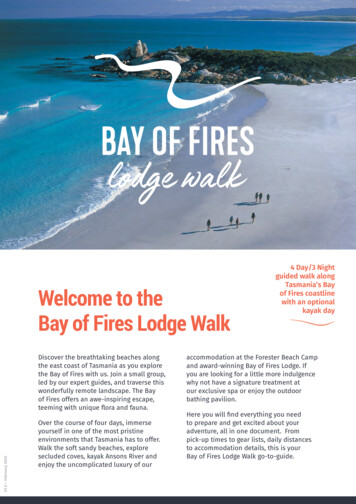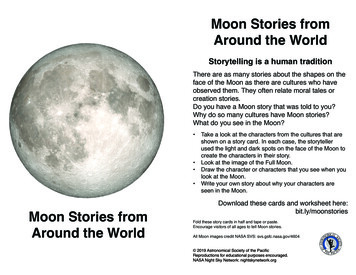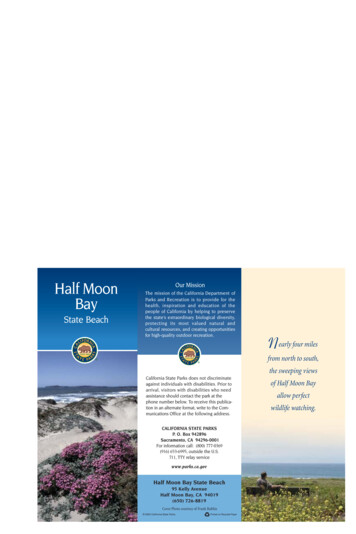
Transcription
vibePoefthBeJa,s1Printed on Recycled PaperCover Photo courtesy of Frank Balthiswildlife watching.allow perfectof Half Moon BayThe mission of the California Department ofParks and Recreation is to provide for thehealth, inspiration and education of thepeople of California by helping to preservethe state’s extraordinary biological diversity,protecting its most valued natural andcultural resources, and creating opportunitiesfor high-quality outdoor recreation.nHMBBrochure PDFlayout 2005 California State Parks95 Kelly AvenueHalf Moon Bay, CA 94019(650) 726-8819Half Moon Bay State Beachwww.parks.ca.govCALIFORNIA STATE PARKSP. O. Box 942896Sacramento, CA 94296-0001For information call: (800) 777-0369(916) 653-6995, outside the U.S.711, TTY relay serviceCalifornia State Parks does not discriminateagainst individuals with disabilities. Prior toarrival, visitors with disabilities who needassistance should contact the park at thephone number below. To receive this publication in an alternate format, write to the Communications Office at the following address.the sweeping viewsfrom north to south,Nearly four milesrumrunners to unload their illegal whiskeyonto smaller boats headed north to SanFrancisco.Natural HistoryThe rugged coastline of Half Moon Bay StateBeach, one-half-mile west of Highway One onKelly Avenue, consists of four smallerbeaches with a two-mile crescent of shoreline. Over the years geologic movement andnearly constant erosion have created adiverse system of mountains, canyons andmarine terraces. Located within the activeSan Andreas and Seal Cove-San GregorioPalo Colorado fault zones, the coastlineshows the uplifting, faulting and foldingactions of millions of years of seismic activity.Semiprecious stones are sometimes foundhere, with various forms of quartz (agate,chert, jasper, hydrolite and onyx) prominent.Inland, sand dunes change constantlyaccording to the season. In winter, wind andstorms tend to carry the sand out to sea, butthe milder wave action of summer monthsState BeachHalf MoonBayOur Missionbrings it back. Primary sources of newbeach sand are eroding bluffs and sediment from the Sacramento and SanJoaquin Rivers.PlantsThe plant communities of Half Moon Bayare not as diverse as they were when thiscoast was pristine. The introduction ofnon-native species such as sea fig, capeivy, New Zealand spinach and poisonhemlock has affected the survival of nativeplants and animals.
late 1800s, when groups arrived from Canada,Italy, Germany, Ireland, China, England,Portugal, Scotland and the Pacific Islands.The first official mention of Half Moon Bay ison an 1854 Coast Survey sketch ofSpanishtown.Before Highway One was built, Prohibition(1920 to 1933) had caused a proliferation ofspeakeasies along the coast. This area’shidden coves and thick fog made it perfectfor the eagerly awaited ships of CanadianPARK HISTORYCultural HistoryBy the time Europeans arrived here, this areahad been occupied for thousands of years byas many as 50 separate and politically autonomous native groups known as the Ohlone. Eachgroup had its own leader, customs andterritory, though some smaller groups wereconnected by shared boundaries, intertribalmarriage and similarities of language.6/28/05, 2:22 PMit, but those who took it over changed itsnatural ecology.In spite of these challenges, today’sOhlone descendents continue the use ofnative plants and are reviving their languages and passing on their honoredtraditions.When the gold rush brought immigrantsfrom Mexico and Chile to the area, SanBenito earned the nickname “Spanishtown.”Its remarkable diversity began during theust off Highway One in Half MoonBay, four small beaches stretchingsouth from Montara Mountain form thegentle two-mile curve of fine, white sandthat is Half Moon Bay State Beach. To theeast the Santa Cruz Mountains frame adramatic backdrop to this captivating northcentral coast region known to localresidents as the “Coastside.” To thewest the enduring Pacific rollsvigorously across the broad, flatbeach. The breakwaters of PillarPoint to the north have a bufferingeffect on the surf, and the waters atthis end of Half Moon Bay StateBeach form a calm surf.The Coastside weather pattern istypical of the north central coast,with cool morning fog and highs inthe mid-60s during the summer.Spring and fall bring clear, crispdays, while wind and rain—brokenby an occasional bright, sunnyday—rule the winter months. Dressing in layers is recommended.According to the diary of Father FranciscoPalou—biographer and successor of FatherJunípero Serra—the native people werefriendly, offering the Spaniards food andguidance through the steep arroyos.Also linguistically referred to asCoastanoans (a name bestowed by thethe mission system. The decline in theOhlone way of life began with the loss oftheir lands and grew rapidly with theintroduction of European diseases. By 1810nearly 70 percent of the Ohlone had perished from disease or had fled to otherareas. Former Ohlone lands—the nucleusof today’s San Mateo County—weregranted to Spanish settlers in the 1840s.The native people had managed theland productively without overexploitingJHousing was simple and food wasplentiful. Alongside trout- and salmon-richfreshwaters, the Ohlone used willowbranches as frames for their dome-shapeddwellings, thatching them with dried tule,cattails or light brush. The ocean providedan abundance of fish, shellfish and seamammals, and the inlandareas were rich in acorns,berries, roots, barks andnuts. The ion, controlledburning, pruning and reseeding in order to encourage the growth of herbs,medicinal plants and desirable food sources. Thesemethods of land management also produced naturalforage that would lure localgame animals.The Ohlone hunted large(deer, bears, elk and seamammals) and small (rabbits, squirrels, skunks andBikers on the Coastside Trail near Dunes Beachvarious birds) game for food.Spanish, meaning coast people), theSome Ohlone artifacts found at the parkOhlones’ ecologically rich territory extendedhave included tools of obsidian and otherfrom the marine environment of today’s Sansharp stones, artfully woven baskets,Francisco inland to the oak/grasslands of thejewelry, clothing and weaponry. What thewestern edge of the San Joaquin Valley andnative people could not make or gathersouth to present-day Carmel. Today’s coastthey obtained in trade with other nativeHighway One and Highway 92 over thegroups.mountains faithfully follow trails created byIn the mid-1700s, Spanish missionariesthe Ohlone.arrived and drew the native people intolinTroF
it, but those who took it over changed itsnatural ecology.In spite of these challenges, today’sOhlone descendents continue the use ofnative plants and are reviving their languages and passing on their honoredtraditions.When the gold rush brought immigrantsfrom Mexico and Chile to the area, SanBenito earned the nickname “Spanishtown.”Its remarkable diversity began during theAccording to the diary of Father FranciscoHousing was simple and food wasPalou—biographer and successor of Fatherplentiful. Alongside trout- and salmon-richJunípero Serra—the native people werefreshwaters, the Ohlone used willowfriendly, offering the Spaniards food andbranches as frames for their dome-shapedguidance through the steep arroyos.dwellings, thatching them with dried tule,Also linguistically referred to ascattails or light brush. The ocean providedCoastanoans (a name bestowed by thean abundance of fish, shellfish and seamammals, and the inlandareas were rich in acorns,berries, roots, barks andnuts. The ion, controlledburning, pruning and reseeding in order to encourage the growth of herbs,medicinal plants and desirable food sources. Thesemethods of land management also produced naturalforage that would lure localgame animals.The Ohlone hunted large(deer, bears, elk and seamammals) and small (rabbits, squirrels, skunks andBikers on the Coastside Trail near Dunes Beachvarious birds) game for food.Some Ohlone artifacts found at the parkhave included tools of obsidian and othersharp stones, artfully woven baskets,jewelry, clothing and weaponry. What thenative people could not make or gatherthey obtained in trade with other nativegroups.In the mid-1700s, Spanish missionariesarrived and drew the native people intoCultural HistoryBy the time Europeans arrived here, this areahad been occupied for thousands of years byas many as 50 separate and politically autonomous native groups known as the Ohlone. Eachgroup had its own leader, customs andterritory, though some smaller groups wereconnected by shared boundaries, intertribalmarriage and similarities of language.the mission system. The decline in theOhlone way of life began with the loss oftheir lands and grew rapidly with theintroduction of European diseases. By 1810nearly 70 percent of the Ohlone had perished from disease or had fled to otherareas. Former Ohlone lands—the nucleusof today’s San Mateo County—weregranted to Spanish settlers in the 1840s.The native people had managed theland productively without overexploitinglate 1800s, when groups arrived from Canada,Italy, Germany, Ireland, China, England,Portugal, Scotland and the Pacific Islands.The first official mention of Half Moon Bay ison an 1854 Coast Survey sketch ofSpanishtown.Before Highway One was built, Prohibition(1920 to 1933) had caused a proliferation ofspeakeasies along the coast. This area’shidden coves and thick fog made it perfectfor the eagerly awaited ships of CanadianNTBKblindruoFJust off Highway One in Half MoonBay, four small beaches stretchingsouth from Montara Mountain form thegentle two-mile curve of fine, white sandthat is Half Moon Bay State Beach. To theeast the Santa Cruz Mountains frame adramatic backdrop to this captivating northcentral coast region known to localresidents as the “Coastside.” To thewest the enduring Pacific rollsvigorously across the broad, flatbeach. The breakwaters of PillarPoint to the north have a bufferingeffect on the surf, and the waters atthis end of Half Moon Bay StateBeach form a calm surf.The Coastside weather pattern istypical of the north central coast,with cool morning fog and highs inthe mid-60s during the summer.Spring and fall bring clear, crispdays, while wind and rain—brokenby an occasional bright, sunnyday—rule the winter months. Dressing in layers is recommended.PARK HISTORYSpanish, meaning coast people), theOhlones’ ecologically rich territory extendedfrom the marine environment of today’s SanFrancisco inland to the oak/grasslands of thewestern edge of the San Joaquin Valley andsouth to present-day Carmel. Today’s coastHighway One and Highway 92 over themountains faithfully follow trails created bythe Ohlone.6/28/05, 2:22 PM
HMBBrochure PDFlayout1 2005 California State ParksPrinted on Recycled PaperCover Photo courtesy of Frank BalthisCBhamgrtcm95 Kelly AvenueHalf Moon Bay, CA 94019(650) 726-8819Half Moon Bay State Beachwww.parks.ca.govCALIFORNIA STATE PARKSP. O. Box 942896Sacramento, CA 94296-0001For information call: (800) 777-0369(916) 653-6995, outside the U.S.711, TTY relay servicewildlife watching.allow perfectof Half Moon Baythe sweeping viewsfrom north to south,Nearly four milesOur MissionNatural HistoryThe rugged coastline of Half Moon Bay StateBeach, one-half-mile west of Highway One onKelly Avenue, consists of four smallerbeaches with a two-mile crescent of shoreline. Over the years geologic movement andnearly constant erosion have created adiverse system of mountains, canyons andHalf MoonBaysgtedcrwvibPetBismarine terraces. Located within the activeSan Andreas and Seal Cove-San GregorioPalo Colorado fault zones, the coastlineshows the uplifting, faulting and foldingactions of millions of years of seismic activity.Semiprecious stones are sometimes foundhere, with various forms of quartz (agate,chert, jasper, hydrolite and onyx) prominent.Inland, sand dunes change constantlyaccording to the season. In winter, wind andstorms tend to carry the sand out to sea, butthe milder wave action of summer monthsState BeachThe mission of the California Department ofParks and Recreation is to provide for thehealth, inspiration and education of thepeople of California by helping to preservethe state’s extraordinary biological diversity,protecting its most valued natural andcultural resources, and creating opportunitiesfor high-quality outdoor recreation.twtSdbdirumrunners to unload their illegal whiskeyonto smaller boats headed north to SanFrancisco.onfCalifornia State Parks does not discriminateagainst individuals with disabilities. Prior toarrival, visitors with disabilities who needassistance should contact the park at thephone number below. To receive this publication in an alternate format, write to the Communications Office at the following address.Pda,brings it back. Primary sources of newbeach sand are eroding bluffs and sediment from the Sacramento and SanJoaquin Rivers.PlantsThe plant communities of Half Moon Bayare not as diverse as they were when thiscoast was pristine. The introduction ofnon-native species such as sea fig, capeivy, New Zealand spinach and poisonhemlock has affected the survival of nativeplants and animals.
Along the Coastside Trail, visitors willsee California poppies, beach primroses,sand verbena, lizardtail, wild radish,mustard, coyote bush and yellow bushlupines. The bluffs and terraces of thehigher elevations have been altered foragricultural purposes, diminishing thepresence of the native sage scrub thatonce dominated the area.area attractive to a number of bird species,including red-tailed hawks, barn owls, redwinged blackbirds and American kestrels.Coyote bush is home to white-crownedsparrows, and jackrabbits and brush rabbitsnibble along the trail's edge.RECREATIONAL ACTIVITIESCoastal access is available at RooseveltBeach, Dunes Beach, Venice Beach andFrancis Beach.Photo courtesy of Frank BalthisCampingThe Francis Beach campground has 52family sites, some suitable for tentcamping, others for trailers or recreational vehicles. Although hookups arenot available, there is a dump station.Coin-operated hot showers are alsoavailable.TrailsThe level, 4-mile multi-use CoastsideTrail extends along the beach’s easternHorse trail along the Coastside TrailPLEASE REMEMBER There are no lifeguard stations at HalfMoon Bay State Beach. Always usecaution in or near the ocean, which isvery cold year round. Even a short swimcan cause cramps or hypothermia (a lifethreatening condition in which yourbody temperature drops below normal). In addition, strong rip currentscan pull even the most experiencedswimmers offshore. Dogs are not permitted on the beaches.When in the campground, in the dayuse picnic areas, or on the CoastsideTrail, dogs must be on a leash no morethan 6 feet long. Horses in the park are restricted to thedesignated horse trail and are notpermitted on the beach. Beach fires are NOT allowed. Shells, driftwood and other natural beachfeatures are protected by State law. Fireworks are prohibited. To prevent vandalism, lock your car,activate the car alarm and take thekey with you. Hide valuables out ofsight. Report any suspicious activityto park staff.This park is supported in part through a nonprofitorganization. For more information contact:San Mateo Coast Natural History Associationc/o Año Nuevo State ReserveNew Years Creek RoadPescadero, CA 94060(650) 879-2041HMBBrochure PDFlayout2FishingFrom late spring throughsummer, Half Moon Bay is notedfor good runs of surf smelt. Anglersuse throw nets and are known to bring alonggear to catch the striped bass thatsometimes follow the smelt.SwimmingSwimming is not recommendedhere because of extremely coldwater temperatures and unpredictable rip currents.Photo courtesy of Frank BalthisAnimalsThe most common birds in this area aremigratory and resident water-associatedbirds such as western snowy plovers, western, California and glaucous-winged gulls,brown pelicans and sanderlings. Offshore,migrating gray whales, California sea lionsand harbor seals provide great wildlifewatching.At Frenchman’s Creek the willow shrubsthat grow along the banks make this riparianboundary from Kelly Avenuenorth to Pillar Point andsouth to Poplar Beach,offering spectacularocean views. Ahorse trail parallels the CoastsideTrail betweenRoosevelt andFrancisBeaches;horses are notpermitted onthe beaches.Restrooms areadjacent to parkingareas.Campground at Francis BeachNEARBYSTATE PARKSPoint Montara Light Station,25 miles south of San Franciscooff Highway One, (650) 728-7177Montara State Beach, 8 miles north of HalfMoon Bay off Highway One,(650) 726-8819San Gregorio State Beach, 10.5 miles southof Half Moon Bay off Highway One,(650) 879-2170ACCESSIBLE FEATURES The Coastside Trail through the park ispaved and accessible. Francis Beach camping, picnicking andbeach access via a beach wheelchair areavailable. Four campsites, threerestrooms, parking and outdoor rinsingshowers are accessibly designed. The park Visitor Center and InformationCenter are both accessible.Accessibility is continually improving. Forcurrent accessibility details call the park, orvisit http://access.parks.ca.gov.SurfingSurfing conditions here are nearlyimpossible to forecast because ofthe unpredictable weather and surfaction. However, depending on thedirection of swell and the level ofsuViThtiona
-rfeVisitor CenterThe park’s visitor center features information and exhibits about the cultural andnatural history of the area. Summer hoursare Thursday through Sundayfrom 10 a.m. to 4 p.m.Call the park forwinter hours.WesternSnowy Plover6/28/05, 2:23 PMSharing the Beach with theWestern Snowy PloverThe western snowy plover that nests atHalf Moon Bay is a sparrow-sized, lightcolored shorebird with dark patches oneither side of its neck, behind its eyes,and on its forehead. The Pacific coastpopulation of the snowy plover, foundon flat, open beaches, in dunes andnear stream mouths, is a threatenedspecies.Extremely difficult to see, the small,well-camouflaged bird lives and nests insmall depressions in the sand. Much ofthe snowy plover’s habitat exists incoastal units of California State Parks.The bird nests in spring and summer,and the first month of life is the mostchallenging for plover chicks. The youngplovers are under constant stress frompeople, feral cats, visiting dogs, nativepredators, and even high-flying kitesthat resemble raptors.The snowy plover has lived on California beaches for thousands of years.However, today its survival is seriouslythreatened.If the snowy plover is to survivehuman use of its natural habitat, itneeds our help. In California’s stateparks, plovers are monitored to determine their numbers, banded to allowlater identification, and protectedbehind temporary fences while they nestand nurture their young. Non-native plantsare removed, and predators are kept undercontrol; if necessary some portions of thebeach may be closed to dogs and people.California State Parks, the U.S. Fish andWildlife Service, and other coastal landmanagers work together to ensure thesuccess of this small shorebird.Avoid approaching fenced or postedhabitat areas; lighting fires or camping onthe beach except in designated areas; anddisturbing areas that provide the ploverswith nesting and feeding habitat. Becauseof the snowy plover’s threatened status, itis protected by the federal EndangeredSpecies Act, and anyone who harms ordisturbs the plover or its habitat may becited and fined.Photo courtesy of Frank Balthisngthe tide, lucky surfers havebeen known to catchsome memorablewaves, particularlyaround thesouthern endof the crescent. A mileoffshorePillar Point,where wavescan reach 20feet in height,the worldfamousMaverick’ssurfing spot is forexperts only. Thegentle swells at TheJetty near El Granada makeit perhaps the most popularsurfing spot in the area for beginners.
Along the Coastside Trail, visitors willsee California poppies, beach primroses,sand verbena, lizardtail, wild radish,mustard, coyote bush and yellow bushlupines. The bluffs and terraces of thehigher elevations have been altered foragricultural purposes, diminishing thepresence of the native sage scrub thatonce dominated the area.area attractive to a number of bird species,including red-tailed hawks, barn owls, redwinged blackbirds and American kestrels.Coyote bush is home to white-crownedsparrows, and jackrabbits and brush rabbitsnibble along the trail's edge.RECREATIONAL ACTIVITIESCoastal access is available at RooseveltBeach, Dunes Beach, Venice Beach andFrancis Beach.Photo courtesy of Frank BalthisCampingThe Francis Beach campground has 52family sites, some suitable for tentcamping, others for trailers or recreational vehicles. Although hookups arenot available, there is a dump station.Coin-operated hot showers are alsoavailable.TrailsThe level, 4-mile multi-use CoastsideTrail extends along the beach’s easternHorse trail along the Coastside TrailPLEASE REMEMBER There are no lifeguard stations at HalfMoon Bay State Beach. Always usecaution in or near the ocean, which isvery cold year round. Even a short swimcan cause cramps or hypothermia (a lifethreatening condition in which yourbody temperature drops below normal). In addition, strong rip currentscan pull even the most experiencedswimmers offshore. Dogs are not permitted on the beaches.When in the campground, in the dayuse picnic areas, or on the CoastsideTrail, dogs must be on a leash no morethan 6 feet long. Horses in the park are restricted to thedesignated horse trail and are notpermitted on the beach. Beach fires are NOT allowed. Shells, driftwood and other natural beachfeatures are protected by State law. Fireworks are prohibited. To prevent vandalism, lock your car,activate the car alarm and take thekey with you. Hide valuables out ofsight. Report any suspicious activityto park staff.This park is supported in part through a nonprofitorganization. For more information contact:San Mateo Coast Natural History Associationc/o Año Nuevo State ReserveNew Years Creek RoadPescadero, CA 94060(650) 879-2041HMBBrochure PDFlayout2FishingFrom late spring throughsummer, Half Moon Bay is notedfor good runs of surf smelt. Anglersuse throw nets and are known to bring alonggear to catch the striped bass thatsometimes follow the smelt.SwimmingSwimming is not recommendedhere because of extremely coldwater temperatures and unpredictable rip currents.Photo courtesy of Frank BalthisAnimalsThe most common birds in this area aremigratory and resident water-associatedbirds such as western snowy plovers, western, California and glaucous-winged gulls,brown pelicans and sanderlings. Offshore,migrating gray whales, California sea lionsand harbor seals provide great wildlifewatching.At Frenchman’s Creek the willow shrubsthat grow along the banks make this riparianboundary from Kelly Avenuenorth to Pillar Point andsouth to Poplar Beach,offering spectacularocean views. Ahorse trail parallels the CoastsideTrail betweenRoosevelt andFrancisBeaches;horses are notpermitted onthe beaches.Restrooms areadjacent to parkingareas.Campground at Francis BeachNEARBYSTATE PARKSPoint Montara Light Station,25 miles south of San Franciscooff Highway One, (650) 728-7177Montara State Beach, 8 miles north of HalfMoon Bay off Highway One,(650) 726-8819San Gregorio State Beach, 10.5 miles southof Half Moon Bay off Highway One,(650) 879-2170ACCESSIBLE FEATURES The Coastside Trail through the park ispaved and accessible. Francis Beach camping, picnicking andbeach access via a beach wheelchair areavailable. Four campsites, threerestrooms, parking and outdoor rinsingshowers are accessibly designed. The park Visitor Center and InformationCenter are both accessible.Accessibility is continually improving. Forcurrent accessibility details call the park, orvisit http://access.parks.ca.gov.SurfingSurfing conditions here are nearlyimpossible to forecast because ofthe unpredictable weather and surfaction. However, depending on thedirection of swell and the level ofsuViThtiona
-rfeVisitor CenterThe park’s visitor center features information and exhibits about the cultural andnatural history of the area. Summer hoursare Thursday through Sundayfrom 10 a.m. to 4 p.m.Call the park forwinter hours.WesternSnowy Plover6/28/05, 2:23 PMSharing the Beach with theWestern Snowy PloverThe western snowy plover that nests atHalf Moon Bay is a sparrow-sized, lightcolored shorebird with dark patches oneither side of its neck, behind its eyes,and on its forehead. The Pacific coastpopulation of the snowy plover, foundon flat, open beaches, in dunes andnear stream mouths, is a threatenedspecies.Extremely difficult to see, the small,well-camouflaged bird lives and nests insmall depressions in the sand. Much ofthe snowy plover’s habitat exists incoastal units of California State Parks.The bird nests in spring and summer,and the first month of life is the mostchallenging for plover chicks. The youngplovers are under constant stress frompeople, feral cats, visiting dogs, nativepredators, and even high-flying kitesthat resemble raptors.The snowy plover has lived on California beaches for thousands of years.However, today its survival is seriouslythreatened.If the snowy plover is to survivehuman use of its natural habitat, itneeds our help. In California’s stateparks, plovers are monitored to determine their numbers, banded to allowlater identification, and protectedbehind temporary fences while they nestand nurture their young. Non-native plantsare removed, and predators are kept undercontrol; if necessary some portions of thebeach may be closed to dogs and people.California State Parks, the U.S. Fish andWildlife Service, and other coastal landmanagers work together to ensure thesuccess of this small shorebird.Avoid approaching fenced or postedhabitat areas; lighting fires or camping onthe beach except in designated areas; anddisturbing areas that provide the ploverswith nesting and feeding habitat. Becauseof the snowy plover’s threatened status, itis protected by the federal EndangeredSpecies Act, and anyone who harms ordisturbs the plover or its habitat may becited and fined.Photo courtesy of Frank Balthisngthe tide, lucky surfers havebeen known to catchsome memorablewaves, particularlyaround thesouthern endof the crescent. A mileoffshorePillar Point,where wavescan reach 20feet in height,the worldfamousMaverick’ssurfing spot is forexperts only. Thegentle swells at TheJetty near El Granada makeit perhaps the most popularsurfing spot in the area for beginners.
The plant communities of Half Moon Bay are not as diverse as they were when this coast was pristine. The introduction of non-native species such as sea fig, cape, New Zealand spinach and poison hemlock has affected the survival of native plants and animals. Half Moon Bay State Beach 95 Kelly Avenue Half Moon Bay, CA 94019 (650) 726-8819
